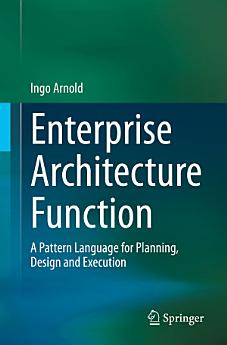Enterprise Architecture Function: A Pattern Language for Planning, Design and Execution
About this ebook
The book is structured in six chapters. Chapter 1 “Introduction” explains the starting position and objectives of the book and introduces key concepts that will be explained further in subsequent chapters. Chapter 2 “Architecture Function Pattern Language” introduces the concepts of pattern, pattern catalogue, pattern topology, and ontology and explains how these concepts are combined to form a pattern language for planning, designing, and operating an architecture function. Next, Chapter 3 “Architecture Function – Context“ introduces concepts that are crucial for understanding the challenges that an architecture function faces and presents a generic schema for the business organizations and value chain. Chapter 4 “Architecture Function – Challenge” looks at an architecture function from a black box perspective and outlines the expectations and requirements that companies place on architecture organizations. It discusses the building blocks of an architecture function, the services it provides along the enterprise value chain, and the quality attributes that enterprises expect from their functions. Chapter 5 “Architecture Function – Constitution” then shifts from a black-box perspective to a white-box perspective and outlines the generic design of an architecture function in order to realize functional and quality-related requirements. Chapter 6 “Pattern Catalogue“ eventually introduces the pattern catalogue with a total of 48 architecture function patterns. These patterns suggest designs for collaboration between the architecture function and enterprise organizations, for the elaboration and development of enterprise services along the enterprise value chain, or for aligning architecture governance with enterprise governance.
The book is intended for a broad readership, including enterprise, domain, and solution architects, lecturers and students, and anyone else interested in understanding the value proposition, responsibilities, outcomes, methods, and practices of architecture functions. It introduces the basic concepts and theories needed to understand the pattern language presented and the patterns it summarizes.
About the author
Ingo Arnold shaped the Enterprise Architecture Function of a global fortune 50s, holding a variety of Architecture Management positions over the last 25 years. In addition to his roles in the industry, Ingo is an Assistant Professor at Universities in Switzerland and Germany sharing his insights and experience with several generations of computer science students. He is also a well-known speaker at professional IT conferences, where he holds presentations on topics such as architecture management and governance, enterprise architecture, and solution architecture for international audiences.




